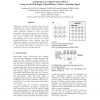Free Online Productivity Tools
i2Speak
i2Symbol
i2OCR
iTex2Img
iWeb2Print
iWeb2Shot
i2Type
iPdf2Split
iPdf2Merge
i2Bopomofo
i2Arabic
i2Style
i2Image
i2PDF
iLatex2Rtf
Sci2ools
91
Voted
IPPS
2006
IEEE
2006
IEEE
Architecture of a multi-context FPGA using a hybrid multiple-valued/binary context switching signal
Multi-context FPGAs have multiple memory bits per configuration bit forming configuration planes for fast switching between contexts. Large amount of memory causes significant overhead in area and power consumption. This paper presents two key technologies. The first is a floating-gate-MOS functional pass gate that merges storage and switching functions area-efficiently. The second is the use of a hybrid multiple-valued/binary context switching signal that eliminates redundancy of a conventional multi-context (MC) switch with high scalability. The transistor count of the proposed MC-switch is reduced to 7% in comparison with that of a SRAM-based one.
Bit Forming Configuration | Context Switching Signal | Distributed And Parallel Computing | IPPS 2006 | Multiple Memory Bits |
| Added | 12 Jun 2010 |
| Updated | 12 Jun 2010 |
| Type | Conference |
| Year | 2006 |
| Where | IPPS |
| Authors | Yoshihiro Nakatani, Masanori Hariyama, Michitaka Kameyama |
Comments (0)

